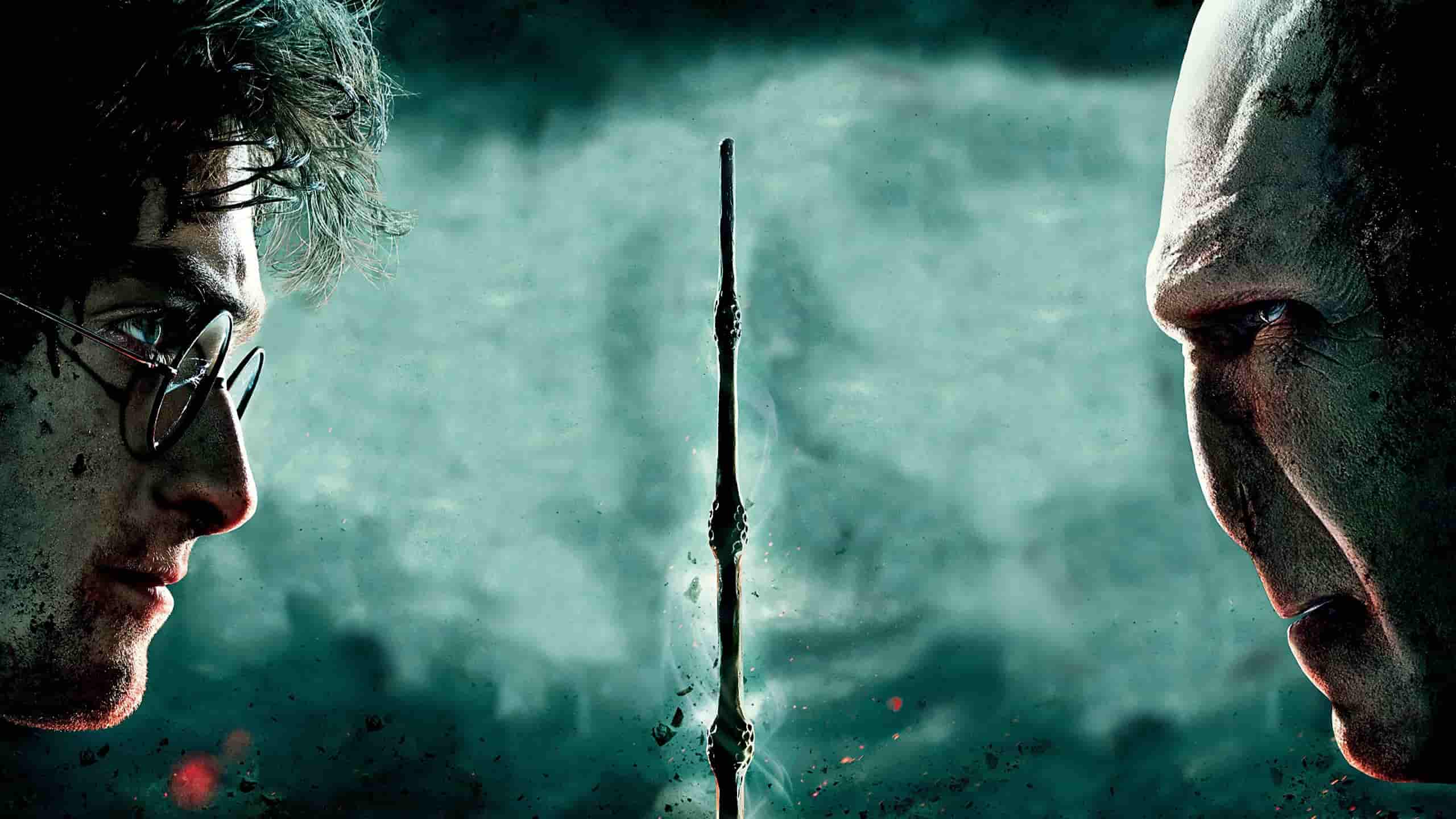Table of Contents
1. Deathly Hallows
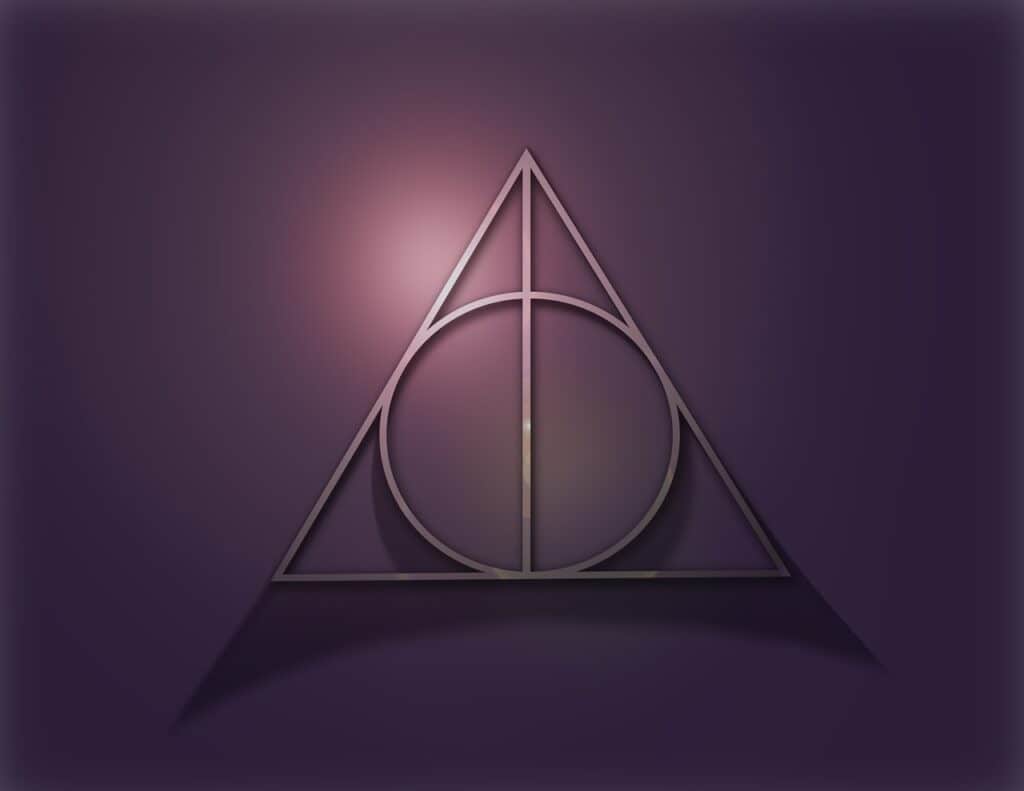
Deathly Hallows are three powerful magical objects created by J.K. Rowling… Ohh sorry, created by Death himself in the Harry Potter universe.
According to legends, these artifacts were created by Death himself and whoever possessed all three (Elder Wand, Resurrection Stone, Invisibility Cloak) would become the Master of Death. The symbols of three Hallows of Death are:
1.1 The Elder Wand (also known as the Deathstick or the Wand of Destiny)
The Elder Wand is one of the three Deathly Hallows, along with the Resurrection Stone and the Cloak of Invisibility. The Elder Wand is known for its immense power and the ability to overpower any other wand it duels with.
The Elder Wand was said to have been created by Death himself and was bestowed upon Antioch Peverell, one of the three Peverell brothers. The wand was passed down through generations, gaining a reputation for its invincibility and the ability to perform extraordinary spells.
The Elder Wand became known as the most powerful wand in existence, capable of performing magic that other wands could not. However, its power also came with a curse. The wand had a history of bringing tragedy and bloodshed to its owners, as it was said that it could only be truly mastered by killing its previous owner.
Harry Potter became the true master of the Elder Wand when he disarmed Draco Malfoy, who had unknowingly become its owner after disarming Dumbledore. Despite being the wand’s master, Harry chose not to keep it and returned it to Dumbledore’s tomb, breaking the cycle of violence associated with its ownership.
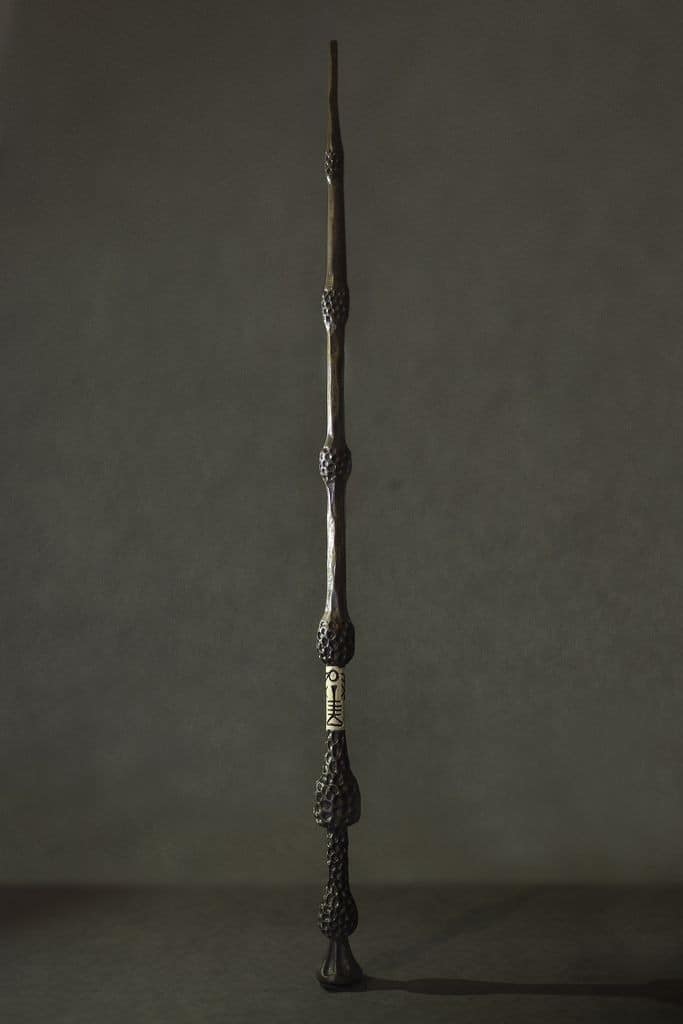
- Appearance: A long, straight wand made of elder wood, with a silver inlay and a Thestral hair core.
- Power: It is said to be the most powerful wand in existence, able to perform feats of magic that other wands cannot. The wand is unbeatable in a duel, and its allegiance can be won by defeating its current owner.
1.2 The Resurrection Stone
The Resurrection Stone is another one of the three Deathly Hallows. It is a small, smooth stone with the power to bring back the spirits of the dead and allow the living to communicate with them. The stone is said to have been a family heirloom of the Peverell family, the descendants of Cadmus Peverell.
According to the legend of the Deathly Hallows, the Resurrection Stone was originally given to Cadmus Peverell by Death himself.
In the Harry Potter series, the Resurrection Stone plays a crucial role in the climactic events of the final book. Harry Potter discovers the stone within a Snitch left to him by Albus Dumbledore. Using the stone, Harry is able to conjure the spirits of his deceased loved ones, including his parents, Sirius Black, and Remus Lupin. The spirits offer him comfort, guidance, and encouragement in his time of need.
However, Harry comes to understand that the Resurrection Stone does not truly bring back the dead, and the spirits he encounters are not the actual individuals, but rather their imprints or memories. Recognizing the importance of accepting death and moving on, Harry decides to discard the stone in the Forbidden Forest, symbolizing his acceptance of mortality and the importance of living in the present.
In essence, the Resurrection Stone is a powerful magical artifact that grants the ability to communicate with the spirits of the deceased. However, it serves as a reminder that death is an inevitable part of life and that clinging to the past can prevent one from fully embracing the present.
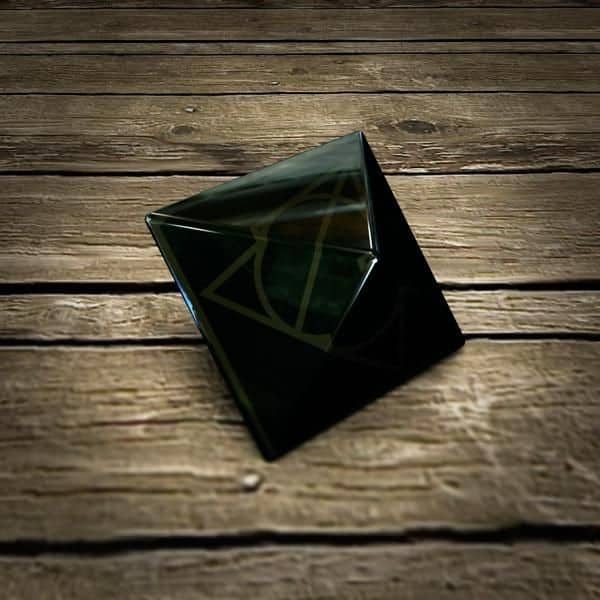
- Appearance: A small, black, smooth stone, with the symbol of the Deathly Hallows engraved on its surface.
- Power: It has the power to bring the dead back to life in a limited form, by summoning their shades or spirits. However, these shades are not truly the deceased person and are incapable of true communication or interaction with the living.
1.3 The Cloak of Invisibility (also known as the Invisibility Cloak)
The Cloak of Invisibility is one of the three Deathly Hallows. As the name suggests, it is a cloak that renders the wearer completely invisible when draped over them. The Cloak is known for its extraordinary power to conceal the presence of the person beneath it, even from magical detection.
According to the legend of the Deathly Hallows, the Cloak of Invisibility was passed down through generations of the Peverell family, originating from Ignotus Peverell, one of the three brothers who first possessed the Hallows.
The Cloak of Invisibility is portrayed as being exceptionally powerful, capable of shielding the wearer from a wide range of detection spells, including those cast by highly skilled wizards. Unlike regular invisibility spells, which can be dispelled or bypassed, the Cloak provides a level of concealment that is difficult to penetrate.
The Cloak of Invisibility serves as a symbol of protection, secrecy, and the power of concealment. It represents the themes of hidden potential and the ability to navigate through the world unseen, allowing its owner to observe and act without being observed.
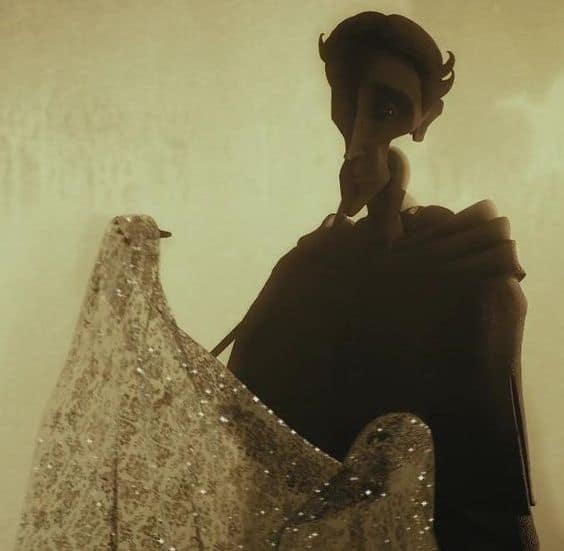
- Appearance: A thin, silvery, and translucent cloak, that grants its wearer true invisibility.
- Power: It can make its wearer completely invisible, and even allow them to move around undetected by magical or non-magical means. It is the most powerful invisibility cloak in existence, and cannot be penetrated by spells or charms.
Individually, each of the Deathly Hallows is incredibly powerful, but together they make their possessor truly unbeatable. However, the legend of the Deathly Hallows also cautions that their combined power can lead to arrogance and greed, ultimately leading to the downfall of the Master of Death.
2. The Symbolism of the Deathly Hallows
The Deathly Hallows possess profound symbolism that resonates throughout the Harry Potter series. These symbols represent overarching themes of power, life, death, choices, and consequences.
2.1 Power and Mastery
The Deathly Hallows symbolizes the pursuit of power and mastery over the magical world. They tempt wizards with their extraordinary abilities, enticing them to seek control and dominance. The allure of power is explored through various characters in the series, highlighting the potential consequences of such desires.
2.2 Life and Death
Life and death are intricately intertwined in the symbolism of the Deathly Hallows. The Resurrection Stone represents the desire to conquer death and reunite with loved ones. However, it teaches valuable lessons about acceptance and the cycle of life. The quest for immortality is a recurring theme, challenging characters to grapple with the inevitability of death.
2.3 Choices and Consequences
The Deathly Hallows symbolizes the choices individuals make and the consequences that follow. Characters are presented with moral dilemmas, testing their integrity and resilience. The pursuit and use of the Deathly Hallows reveal the repercussions of one’s decisions, highlighting the importance of making choices wisely.
3. The Magical Powers of the Deathly Hallows
Each of the Deathly Hallows possesses extraordinary magical powers that contribute to their allure and mystique. Let’s explore the unique abilities of these artifacts.
3.1 The Elder Wand’s Power
The Elder Wand is the most powerful wand in existence, capable of performing spells and enchantments beyond the reach of ordinary wands. Its true master holds unparalleled magical strength, easily overpowering opponents. The Elder Wand’s mastery over magic is a testament to its legendary status.
3.2 The Resurrection Stone’s Power
The Resurrection Stone, while unable to bring back the dead, allows the bearer to briefly communicate with departed souls. It offers comfort and closure, granting individuals a precious moment of connection with those they have lost. The Resurrection Stone’s power lies in its ability to provide solace and acceptance.
3.3 The Invisibility Cloak’s Power
The Invisibility Cloak, the oldest and most powerful of its kind, grants the wearer absolute invisibility. It shields the user from prying eyes, enabling them to move undetected. The Invisibility Cloak’s power provides a valuable advantage, allowing individuals to navigate perilous situations and gather information discreetly.
4. The Quest for the Deathly Hallows
The quest for the Deathly Hallows forms a significant part of Harry Potter’s journey. Guided by the legend of the three brothers, Harry embarks on a quest to uncover the truth behind the Deathly Hallows and their connection to the dark wizard Lord Voldemort.
4.1 Harry Potter’s Journey
Harry Potter, driven by curiosity and the desire to defeat Voldemort, seeks to understand the Deathly Hallows and their significance. His journey takes him through thrilling adventures and dangerous encounters as he attempts to master the power of the artifacts and use them for the greater good.
4.2 The Tale of the Three Brothers
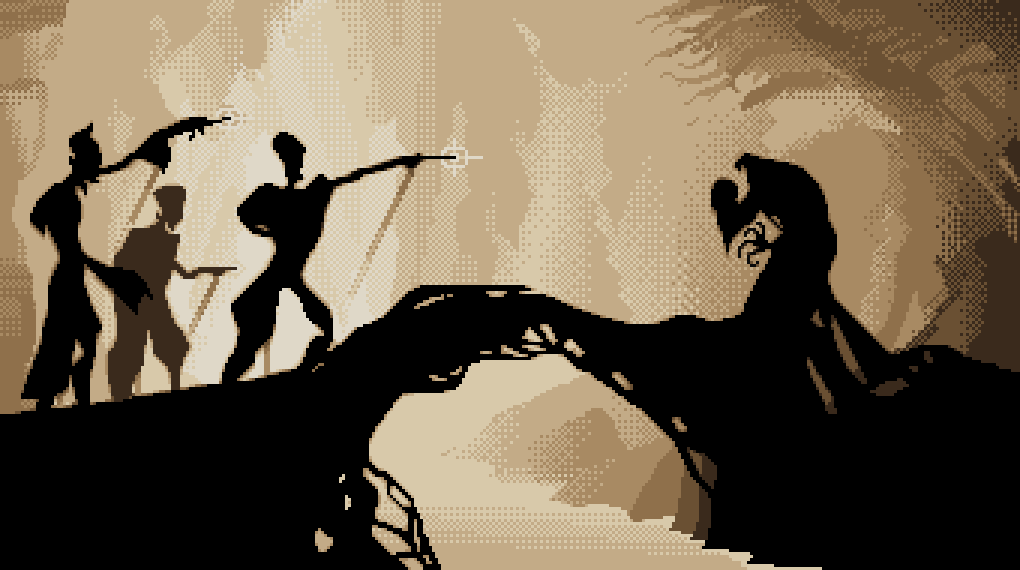
The tale of the three brothers, introduced in “The Tales of Beedle the Bard,” reveals the origin and the story of the Deathly Hallows and imparts important lessons about humility and wisdom. This fable serves as a guiding narrative throughout the series, shaping the characters’ understanding of power and the consequences it entails.
Hello, Fellow Half-bloods this is your Lord…. Don’t mind… your most cunning friend Tom Riddle telling you the tales of Deathly Hallows which most unfortunately I was not able to possess ever. Although I didn’t know about any of the Hallows until I kidnapped Garrick Ollivander and tortured him into telling everything about the most powerful wand in the world or death stick.
But still, let me tell you the story of deathly hallows about which I came to know once I visited poor mugwump Albus Dumbledore at his portrait after yet another unfortunate disposal of myself by the boy who should not be lived.
So the story begins many centuries ago when three Peverell brothers Antioch, Cadmus, and Ignotus were traveling along in twilight at a deserted road. As the brothers ventured forward, their journey led them to a formidable river, its depths too profound to wade through and its currents too treacherous to brave by swimming. Undeterred by this obstacle, the brothers, well-versed in the arcane arts, skillfully brandished their wands, evoking the power of magic to manifest a sturdy bridge over the hazardous waters. With each step, they traversed the bridge, progressing confidently toward their destination. However, as they reached the midpoint of their crossing, an enigmatic figure cloaked in a hood emerged, blocking their path.
And Death addressed them, seething with anger at having been deprived of three new victims, as travelers often succumbed to the river’s depths. Yet, Death, cunning as ever, disguised his frustration and extended false congratulations to the three brothers for their mastery of magic. He acknowledged their cleverness in eluding him and declared that each deserved a reward.
The eldest brother, known for his combative nature, boldly demanded a wand surpassing all others—a wand that would unfailingly ensure victory in any duel, a wand befitting a wizard who had conquered Death itself! Yielding to the request, Death made his way to an elder tree by the riverbank, fashioned a wand from a hanging branch, and presented it to the eldest brother.
Next, the second brother, consumed by arrogance, sought to humiliate Death even further. He yearned for the power to recall departed souls from Death’s grasp. Obliging the request, Death retrieved a stone from the river’s edge and handed it to the second brother, assuring him that the stone possessed the ability to resurrect the dead.
Finally, Death turned to the third and youngest brother and inquired about his desires. The youngest brother, humble and wise among the siblings, harbored suspicion toward Death. He sought something that would enable him to traverse the realm without being pursued by Death’s looming presence. Reluctantly, Death relinquished his own Cloak of Invisibility, handing it over to the youngest brother, though his reluctance was palpable.
Death stepped aside, permitting the three brothers to proceed on their journey. They marveled at the adventure they had just experienced and admired Death’s bestowed gifts. Eventually, the brothers went their separate ways.
The first brother continued for days until he arrived at a distant village, seeking out a wizard he had quarreled with. Armed with the Elder Wand, he easily triumphed in their ensuing duel, leaving his enemy lifeless on the floor. Boasting at an inn about his invincibility, thanks to the powerful wand he had taken from Death himself, the eldest brother never suspected danger. That very night, a thief sneaked upon him while he lay inebriated, claiming the wand and, as an added measure, slitting the oldest brother’s throat. Thus, Death claimed the first brother as his own.
Meanwhile, the second brother returned to his solitary home. There, he retrieved the stone that possessed the ability to summon the dead. Turning it three times in his hand, he was astounded when the apparition of the girl he had once desired to marry, now deceased, materialized before him. However, she remained melancholic and distant, separated from him as if by an insurmountable barrier. Though she had returned to the realm of the living, she did not truly belong, enduring a perpetual state of suffering. Consumed by insurmountable longing, the second brother, in despair, took his own life to join her in death. And thus, Death claimed the second brother as his own.
Despite Death’s relentless pursuit, the third brother eluded him for many years. Only in his old age did the youngest brother relinquish the Cloak of Invisibility to his son. Embracing Death as an old friend, the youngest brother departed from this world, willingly accompanying Death as an equal.
And so, the three brothers met different fates, with Death claiming the first and second brother as his own, while the elusive third brother greeted Death as a companion, transcending mortality in peaceful unity.
This was as long ago told by Beedle the Bard and since then re-told many times.
However, Dumbledore recently told me that in his opinion, it was more plausible to consider the Peverell brothers as exceptionally skilled and formidable wizards who were able to craft those potent artifacts. The notion that they were Death’s personal Hallows appears to be the kind of mythical tale that often emerges around such extraordinary creations.”
I left it upon you to debate over the origin of these hallows as neither I was nor I am interested in any of the hallows created by the Peverell brothers or Death or by my dear J. K. Rowling except for the most powerful wand, The Elder wand. I was also busy protecting myself by creating several Horcruxes instead being dependent on some Hallows.
5. Conclusion
The Deathly Hallows symbols hold immense power and meaning within the world of Harry Potter. Through the Elder Wand, the Resurrection Stone, and the Invisibility Cloak, J.K. Rowling crafts a story that explores themes of power, life, death, choices, and consequences. The quest for these artifacts leads characters on a journey of self-discovery, showcasing the transformative power of their decisions.
6. Deathly Hallows: Frequently Asked Questions
1. What are the Deathly Hallows symbols?

The Deathly Hallows symbols refer to the three magical artifacts, namely the Elder Wand, the Resurrection Stone, and the Invisibility Cloak, which hold significant power and symbolism in the Harry Potter series.
2. What powers do the Deathly Hallows possess?
The Elder Wand possesses unbeatable magical power, the Resurrection Stone allows brief communication with the dead, and the Invisibility Cloak renders the wearer completely invisible.
3. How does Harry Potter encounter the Deathly Hallows?
Harry Potter learns about the Deathly Hallows through the tale of the three brothers and embarks on a quest to understand their significance and their connection to Lord Voldemort.
4. Can anyone wield the power of the Deathly Hallows?
The power of the Deathly Hallows is not easily controlled or harnessed by anyone. They require great skill, wisdom, and sometimes sacrifice to wield their power effectively.
5. Are the Deathly Hallows real artifacts?
No, the Deathly Hallows are fictional artifacts created by J.K. Rowling for the Harry Potter series. They exist solely within the realm of imagination and storytelling.
